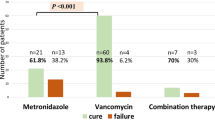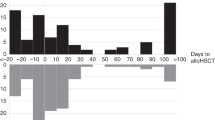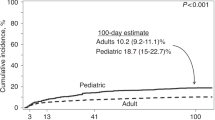Abstract
We retrospectively evaluated 75 allogeneic stem cell transplant recipients to ascertain the incidence, risk factors and outcome of infection with Clostridium difficile. Ten patients (13%) had Clostridium difficile infection at a median of 38 days (range day −6 to day +72) following the transplant. There was no difference in the duration or severity of diarrhoea in patients with Clostridium difficile infection compared to the uninfected patients and no relationship to the prior antibiotic or chemotherapy usage, age, gender, underlying disease, donor type, CMV serostatus, total body irradiation or time to engraftment. The incidence of viral infections was increased in patients infected with Clostridium difficile (7/10 vs 15/65, P = 0.005, odds ratio 7.7), but the strongest association was with gvhd >grade 2 (5/10 vs 6/65 uninfected patients, P = 0.004, odds ratio 9.8). Patients infected with Clostridium difficile also suffered a higher non-relapse mortality with 7/10 patients succumbing to either GVHD or infections, compared to 19/65 patients in the uninfected group (P = 0.02, odds ratio 5.6). Thus Clostridium difficile infections in our study had a strong association with GVHD and increased non-relapse mortality. It is possible that Clostridium difficile toxin might predispose to increased severity of GVHD leading to an adverse outcome. Bone Marrow Transplantation (2000) 26, 871–876.
This is a preview of subscription content, access via your institution
Access options
Subscribe to this journal
Receive 12 print issues and online access
$259.00 per year
only $21.58 per issue
Buy this article
- Purchase on Springer Link
- Instant access to full article PDF
Prices may be subject to local taxes which are calculated during checkout

Similar content being viewed by others
References
Bartlett JG . Antibiotic-associated diarrhoea Clin Infect Dis 1992 15: 573–581
Anand A, Glatt AE . Clostridium difficile infection associated with antineoplastic chemotherapy: a review Clin Infect Dis 1993 17: 109–113
Yolken RH, Bishop CA, Timothy TR et al. Infectious gastroenteritis in bone marrow transplant recipients New Engl J Med 1982 306: 1010–1012
Cox GJ, Matsui SM, Lo RS et al. Etiology and outcome of diarrhea after marrow transplantation: a prospective study Gastroenterology 1994 107: 1398–1407
Blakey JL, Barnes GL, Bishop RF, Ekert H . Infectious diarrhea in children undergoing bone marrow transplantation Aust N Z J Med 1989 19: 31–36
Bilgrami S, Feingold JM, Dorsky D et al. Incidence and outcome of Clostridium difficile infection following autologous peripheral blood stem cell transplantation Bone Marrow Transplant 1999 23: 1039–1042
Avery R, Pohlman B, Adal K et al. High prevalence of diarrhoea but infrequency of documented Clostridium difficile in autologous peripheral blood progenitor cell transplant recipients Bone Marrow Transplant 2000 25: 67–69
Beelen DW, Haralambie E, Brandt H et al. Evidence that sustained growth suppression of intestinal anaerobic bacteria reduces the risk of acute graft-versus-host disease after sibling marrow transplantation Blood 1992 80: 2668–2676
Thomas ED, Storb R, Clift RA et al. Bone marrow transplantation New Engl J Med 1975 292: 895–902
Barbut F, Meynard JL, Guiguet M et al. Clostridium difficile-associated diarrhea in HIV-infected patients: epidemiology and risk factors J Acquir Immune Defic Syndr Hum Retrovirol 1997 16: 176–181
Kelly CP . Immune response to Clostridium difficile infection Eur J Gastroenterol Hepatol 1996 8: 1048–1053
Beelen DW, Elmaagacli A, Muller KD et al. Influence of intestinal bacterial decontamination using metronidazole and ciprofloxacin or ciprofloxacin alone on the development of acute graft-versus-host disease after marrow transplantation in patients with hematologic malignancies: final results and long-term follow-up of an open-label prospective randomized trial Blood 1999 93: 3267–3275
Hill GR, Krengler W, Ferrara JM . The role of cytokines in acute graft-versus-host disease Cytokines Cell Mol Ther 1997 3: 257–266
Hill GR, Crawford JM, Cooke KR et al. Total body irradiation and acute graft-versus-host disease: the role of gastrointestinal damage and inflammatory cytokines Blood 1997 90: 3204–3213
Piguet PF, Grau GE, Allet B et al. Tumour necrosis factor/cachectin is an effector of skin and gut lesions of the acute phase of graft-versus-host disease J Exp Med 1987 166: 1280–1289
Van Bekkum DW, Knaan S . Role of bacterial flora in development of intestinal lesions from graft-versus-host disease J Natl Cancer Inst 1977 58: 787–790
Mazuski JE, Panesar N, Tolman K, Longo WE . In vitro effects of Clostridium difficile toxins on hepatocytes J Surg Res 1998 79: 170–178
Melo Filho AA, Souza MH, Lyerly DM et al. Role of tumour necrosis factor and nitric oxide in the cytotoxic effects ofClostridium difficile toxin A and toxin B on macrophages Toxicon 1997 35: 743–752
Feltis BA, Kim AS, Kinneberg KM et al. Clostridium difficile toxins may augment bacterial penetration of intestinal epithelium Arch Surg 1999 134: 1235–1241
Heinzelmann M, Mercer-Jones MA, Gardner SA et al. Bacterial cell wall products increase monocyte HLA-DR and ICAM-1 without affecting lymphocyte CD 18 expression Cell Immunol 1997 176: 127–134
Cleary RK, Grossmann R, Fernandez FB et al. Metronidazole may inhibit intestinal colonization with Clostridium difficile Dis Colon Rectum 1998 41: 464–467
Author information
Authors and Affiliations
Rights and permissions
About this article
Cite this article
Chakrabarti, S., Lees, A., Jones, S. et al. Clostridium difficile infection in allogeneic stem cell transplant recipients is associated with severe graft-versus-host disease and non-relapse mortality. Bone Marrow Transplant 26, 871–876 (2000). https://doi.org/10.1038/sj.bmt.1702627
Received:
Accepted:
Published:
Issue Date:
DOI: https://doi.org/10.1038/sj.bmt.1702627
Keywords
This article is cited by
-
Non-viral pathogens of infectious diarrhoea post-allogeneic stem cell transplantation are associated with graft-versus-host disease
Annals of Hematology (2024)
-
The incidence and impact of clostridioides difficile infection on transplant outcomes in acute leukemia and MDS after allogeneic hematopoietic cell transplant—a CIBMTR study
Bone Marrow Transplantation (2023)
-
Clostridium Difficile infections in patients with AML or MDS undergoing allogeneic hematopoietic stem cell transplantation identify high risk for adverse outcome
Bone Marrow Transplantation (2020)
-
Microbiome: An Emerging New Frontier in Graft-Versus-Host Disease
Digestive Diseases and Sciences (2019)
-
Prognosis of Clostridium difficile infection in adult oncohaematological patients: experience from a large prospective observational study
European Journal of Clinical Microbiology & Infectious Diseases (2018)



